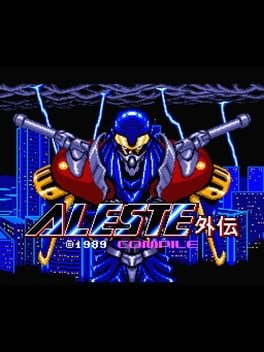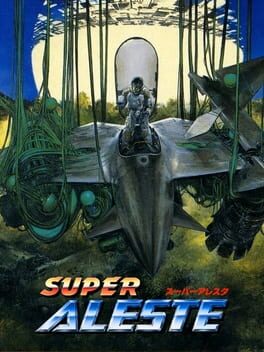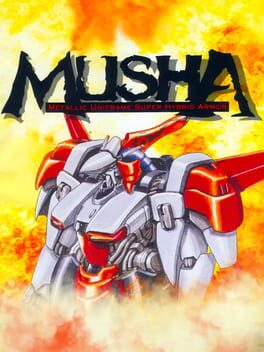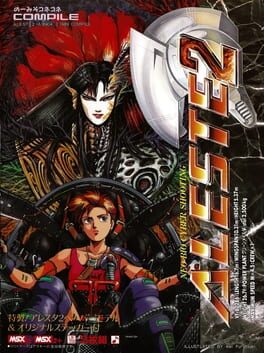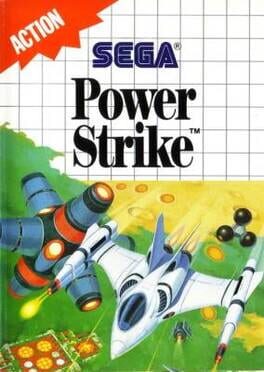

Aleste Gaiden is a vertical shoot 'em up video game developed by Compile in 1989. It was released onto MSX2 in Japan only. It was originally released as part of the Disc Station Special Vol. 4. As it's title implies, it is a spin-off which retells the story of the first game in a different setting.
Also in series
Reviews View More
Compile's arcade shooters have earned a reputation, for better or worse. Aleste Gaiden isn't going to change your mind about that. It's a solid appetizer, possessing many of the distinctive bits found in its series cousins; you won't find a less offensive '80s STG from the long-defunct studio. Likewise, its limited development time and budget hints at another purpose, playing sideshow to the more ambitious Aleste 2 releasing two months later. All this works to the game's benefit, turning a competent but standard riff on previous MSX shooters into something more contextually interesting.
Some would take one look at this and say "well there's barely anything here!", but that's got an explanation too. Just as European micro-computers had their own budget games market, so too did the Japanese PC sphere. Reprint brands like SOFBOX syndicated software from many companies like Bothtec or Falcom. Brother Industries ran a floppy disk vending machine service, their Takeru brand, to cheaply distribute big-box games on new or rewritable disks, plus many indie exclusives. And, akin to the cover disks packed in with hobby publications throughout the UK and other countries, disk magazines spread throughout Japan via MSXFan and competing lines, giving most users something to slap into their machine. Compile stood out here, creating and distributing their own Disc Station print-plus-digital magazine via mail order. They only sold Aleste Gaiden and similarly short affairs through this service, either in the main series or in special, somewhat pricier box volumes.
Like its companion piece on Disc Station Special Vol. 4, the more idiosyncratic strategy-sim Children's Wars, Aleste Gaiden eats up a whole disk, but feels much slimmer on content than pricier one-disk MSX2 titles. The slow, music-less opening shows a familiar hero, Raymond Waizen, donning a powerful exoskeleton before leaving to defeat the aberrant DIA 51 system yet again. We're not blasting through the typical sci-fi planet environments here, though. This side-story's set in a post-apocalyptic Earth, with the first stage literally having you dodge fallen Statue of Liberty heads as if the 3D printers all got carried away! This game only has 5 short levels, generally increasing in challenge while recycling several enemy types aside from bosses. It's an economic affair, even borrowing most of its soundtrack from the recent MSX2 version of Golvellius, though at least the opening and ending themes are new.
Mechanics are usually what Compile's classic STGs do best, and that's generally the case here. Ray's got a decent pea-shooter attack, plus a Raiden-style choice between three shot types you pick up from destroyable enemies. I stuck to the initial throwing stars and had no trouble that way, but the fast lasers and much slower fire circles can suit others' playstyles better. Another ballistic blimp drops the Big O, which you can pick up to add a max of two Gradius-style option clones trailing behind you. These shadow fighters never die and let you spread fire across the screen with some finesse, a smart compromise to help players while avoiding slowdown. Rounding everything out is the jump button. You heard me right: there's platforming in this one, albeit on the simple side to add variety. There's no concept of height for dodging bullets, but you'll need to hop around unless falling to your doom sounds fun (let alone catching on obstacles).
Pair all the above with customary vertical scrolling stages and that's the game loop. Aleste Gaiden is far from ambitious, content to stay within the lane set by Konami's Knightmare & Capcom's Commando years before. Not even Compile's famed numbered weapon system from previous Zanac and Aleste games appears here! So this game rides or dies based on how fun the levels themselves are, more than its basic systems. I'm happy to report that Gaiden's brevity works in its favor. None of the stages ever overstay their welcome the way you'd expect from some of its contemporaries. Enemies and waves are simple in concept, but combine in ways that can throw you off when least expected. The platforming integrates into bullet dodging and item management without feeling vestigial. Really, the only weak link is the boss design overall, with none of the end-level baddies ever posing a threat like the screens before them.
Another plus for Aleste Gaiden is its presentation. The graphics look nice for a later MSX2 game, with consistently smooth vertical scrolling and sprite movement. Everything sports a colorful but recognizably cyberpunk-ish design philosophy, from the generic robo-soliders you gun down to stage 3's eerily angelic boss fight. Compile's team did what they could to imply a story progression with so little, taking you from city streets to wilderness ruins before cutting sharply to an alien-looking enemy headquarters with hexagonal flooring. Most importantly, there's scarcely any moment where I couldn't read and dodge enemy bullet trails, and that's saying something since screen readability in Compile J-PC STGs wasn't that great back then. Maybe the music's mostly lifted from Golvellius, but they made smart track choices nonetheless; I've got nothing to say about the sound design, either. It's a handsome snack of an MSX2 shooter.
So if the game's pleasant but less than memorable, why does this one stick out so much to me? I think it's that feeling of Compile revisiting their roots, right before the ascent of Madou Monogatari & especially Puyo Puyo among the company's brands. Aleste Gaiden's largely the work of staff who'd just joined or been recruited, a way for them to hone their development skills while shipping a fun game. It makes sense that this game, though using MSX2-level audiovisuals, could easily work on an early-'80s original MSX with some smart coding. Compile's own veterans had moved on to more ambitious projects like The Guardian Legend or Alien Crush, but here's a throwback shooter at a time when that concept seemed novel. Despite having every chance to make some nostalgic cash-in on Xevious and others in the Japanese arcade pantheon, Aleste Gaiden retains something of its own identity, mainly via its platforming & on-ground running and gunning. Amateurish, yet refined…that's a winning combo to me.
Give this late-'80s little ditty a try if you're bored and want a quick 1CC. (The game also gives you infinite continues, which can help if those tricky patterns on the final stage keep you down.) Better yet, treat this as an intro to Compile's vast Disc Station series of games, doodads, and other neat software things. Their disk magazines would only improve over time from the MSX days, arguably peaking in the late-'90s by providing a lot of needed Windows 95 games for starved Japanese players. Until then, Alesta Gaiden saw the studio reaching its peak period with shooter design, some years before their STG pros left to form Raizing and other off-shoots. It's part of a long legacy debated and engaged with to this day, and I don't think it's prudent to leave even the most minor experiences out of the discussion.
Some would take one look at this and say "well there's barely anything here!", but that's got an explanation too. Just as European micro-computers had their own budget games market, so too did the Japanese PC sphere. Reprint brands like SOFBOX syndicated software from many companies like Bothtec or Falcom. Brother Industries ran a floppy disk vending machine service, their Takeru brand, to cheaply distribute big-box games on new or rewritable disks, plus many indie exclusives. And, akin to the cover disks packed in with hobby publications throughout the UK and other countries, disk magazines spread throughout Japan via MSXFan and competing lines, giving most users something to slap into their machine. Compile stood out here, creating and distributing their own Disc Station print-plus-digital magazine via mail order. They only sold Aleste Gaiden and similarly short affairs through this service, either in the main series or in special, somewhat pricier box volumes.
Like its companion piece on Disc Station Special Vol. 4, the more idiosyncratic strategy-sim Children's Wars, Aleste Gaiden eats up a whole disk, but feels much slimmer on content than pricier one-disk MSX2 titles. The slow, music-less opening shows a familiar hero, Raymond Waizen, donning a powerful exoskeleton before leaving to defeat the aberrant DIA 51 system yet again. We're not blasting through the typical sci-fi planet environments here, though. This side-story's set in a post-apocalyptic Earth, with the first stage literally having you dodge fallen Statue of Liberty heads as if the 3D printers all got carried away! This game only has 5 short levels, generally increasing in challenge while recycling several enemy types aside from bosses. It's an economic affair, even borrowing most of its soundtrack from the recent MSX2 version of Golvellius, though at least the opening and ending themes are new.
Mechanics are usually what Compile's classic STGs do best, and that's generally the case here. Ray's got a decent pea-shooter attack, plus a Raiden-style choice between three shot types you pick up from destroyable enemies. I stuck to the initial throwing stars and had no trouble that way, but the fast lasers and much slower fire circles can suit others' playstyles better. Another ballistic blimp drops the Big O, which you can pick up to add a max of two Gradius-style option clones trailing behind you. These shadow fighters never die and let you spread fire across the screen with some finesse, a smart compromise to help players while avoiding slowdown. Rounding everything out is the jump button. You heard me right: there's platforming in this one, albeit on the simple side to add variety. There's no concept of height for dodging bullets, but you'll need to hop around unless falling to your doom sounds fun (let alone catching on obstacles).
Pair all the above with customary vertical scrolling stages and that's the game loop. Aleste Gaiden is far from ambitious, content to stay within the lane set by Konami's Knightmare & Capcom's Commando years before. Not even Compile's famed numbered weapon system from previous Zanac and Aleste games appears here! So this game rides or dies based on how fun the levels themselves are, more than its basic systems. I'm happy to report that Gaiden's brevity works in its favor. None of the stages ever overstay their welcome the way you'd expect from some of its contemporaries. Enemies and waves are simple in concept, but combine in ways that can throw you off when least expected. The platforming integrates into bullet dodging and item management without feeling vestigial. Really, the only weak link is the boss design overall, with none of the end-level baddies ever posing a threat like the screens before them.
Another plus for Aleste Gaiden is its presentation. The graphics look nice for a later MSX2 game, with consistently smooth vertical scrolling and sprite movement. Everything sports a colorful but recognizably cyberpunk-ish design philosophy, from the generic robo-soliders you gun down to stage 3's eerily angelic boss fight. Compile's team did what they could to imply a story progression with so little, taking you from city streets to wilderness ruins before cutting sharply to an alien-looking enemy headquarters with hexagonal flooring. Most importantly, there's scarcely any moment where I couldn't read and dodge enemy bullet trails, and that's saying something since screen readability in Compile J-PC STGs wasn't that great back then. Maybe the music's mostly lifted from Golvellius, but they made smart track choices nonetheless; I've got nothing to say about the sound design, either. It's a handsome snack of an MSX2 shooter.
So if the game's pleasant but less than memorable, why does this one stick out so much to me? I think it's that feeling of Compile revisiting their roots, right before the ascent of Madou Monogatari & especially Puyo Puyo among the company's brands. Aleste Gaiden's largely the work of staff who'd just joined or been recruited, a way for them to hone their development skills while shipping a fun game. It makes sense that this game, though using MSX2-level audiovisuals, could easily work on an early-'80s original MSX with some smart coding. Compile's own veterans had moved on to more ambitious projects like The Guardian Legend or Alien Crush, but here's a throwback shooter at a time when that concept seemed novel. Despite having every chance to make some nostalgic cash-in on Xevious and others in the Japanese arcade pantheon, Aleste Gaiden retains something of its own identity, mainly via its platforming & on-ground running and gunning. Amateurish, yet refined…that's a winning combo to me.
Give this late-'80s little ditty a try if you're bored and want a quick 1CC. (The game also gives you infinite continues, which can help if those tricky patterns on the final stage keep you down.) Better yet, treat this as an intro to Compile's vast Disc Station series of games, doodads, and other neat software things. Their disk magazines would only improve over time from the MSX days, arguably peaking in the late-'90s by providing a lot of needed Windows 95 games for starved Japanese players. Until then, Alesta Gaiden saw the studio reaching its peak period with shooter design, some years before their STG pros left to form Raizing and other off-shoots. It's part of a long legacy debated and engaged with to this day, and I don't think it's prudent to leave even the most minor experiences out of the discussion.
A coisa mais “inovadora” do jogo é que, em vez de você controlar uma navinha, agora controla um personagem de anime armadurado correndo feito louco. A possibilidade que isso cria de se inserir alguns elementos de platforming está presente – há um botão de pulo e certos abismos nos estágios – mas isso é utilizado de forma tímida e não muito interessante. Fora isso, só tenho pontos negativos a salientar: extremamente repetitivo, chefes fracos, níveis entediantes e ainda tiraram o sistema de armas do primeiro Aleste, que era a sua melhor parte.
